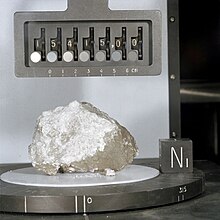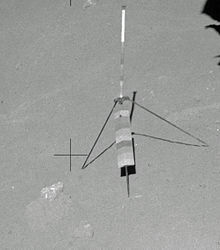Genesis Rock



The Genesis Rock (sample 15415) is a sample of Moon rock retrieved by Apollo 15 astronauts James Irwin and David Scott in 1971 during the second lunar EVA, at Spur crater on Earth's Moon. With a mass of c. 270 grams (4,200 grains),[1] it is currently stored at the Lunar Sample Laboratory Facility in Houston, Texas.
Rock
[edit]Chemical analysis of the Genesis Rock indicated it is an anorthosite, composed mostly of a type of plagioclase feldspar known as anorthite. The rock was formed in the early stages of the Solar System, at least 4 billion years ago.[2]
It was originally thought they had found a piece of the Moon's primordial crust, but later analysis initially showed that the rock was only 4.1 ± 0.1 billion years old, which is younger than the Moon itself, and was formed after the Moon's crust had already solidified. Research has shown that the Genesis Rock is not the oldest sample recovered from the moon, with sample 14321 (retrieved during the Apollo 14 mission) surpassing it.[3] It is still an extremely old sample, formed during the Pre-Nectarian period of the Moon's history. Dating of pyroxenes from other lunar anorthosite samples gave a samarium–neodymium age of crystallization of 4.46 billion years.[4] Other research methods approximate the age of the rock to be between 4 and 5 billion years old.[5]
See also
[edit]- Apollo 15 operations on the Lunar surface
- Hadley–Apennine
- Lunar sample displays
- Stolen and missing Moon rocks
References
[edit]- ^ "15415 Ferroan Anorthosite" (PDF). NASA. Retrieved November 29, 2022.
- ^ Apollo 15 samples overview Lunar and Planetary Institute
- ^ Association (USRA), Universities Space Research. "Earth's Oldest Rock Found on the Moon". NASA Solar System Exploration. Retrieved 2023-08-15.
- ^ Norman, M. D., Borg, L. E., Nyquist, L. E., and Bogard, D. D. (2003) Chronology, geochemistry, and petrology of a ferroan noritic anorthosite clast from Descartes breccia 67215: Clues to the age, origin, structure, and impact history of the lunar crust, Meteoritics and Planetary Science, vol 38, p. 645-661 Summary
- ^ Wasserburg, G. J.; Papanastassiou, D. A. (1971-12-02). "Age of an Apollo 15 mare basalt; Lunar crust and mantle evolution". Earth and Planetary Science Letters. 13 (1): 97–104. Bibcode:1971E&PSL..13...97W. doi:10.1016/0012-821X(71)90110-5. ISSN 0012-821X.
External links
[edit]- Lunar and Planetary Institute - Apollo 15
- NASA - Apollo 15
- Discovering the Genesis Rock Archived 2021-01-25 at the Wayback Machine (From the Apollo Lunar Surface Journal, scroll down to 145:41:48.)
- Astronaut Scott examines the Genesis rock. (image Archived 2021-08-01 at the Wayback Machine)
- An overview of the samples collected by Apollo 15. (The Genesis Rock is sample #15415 and is described but not listed by its number.)

